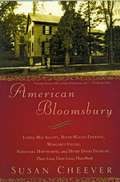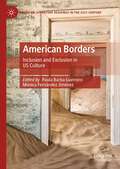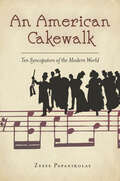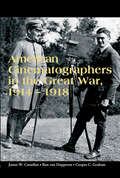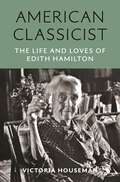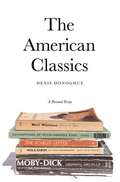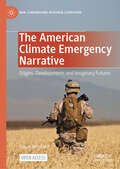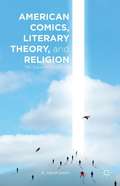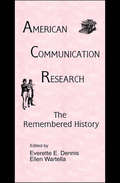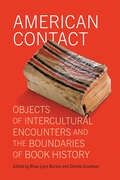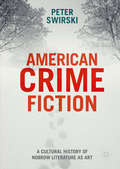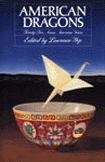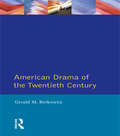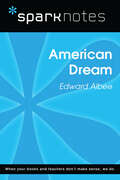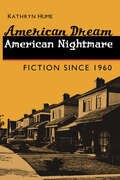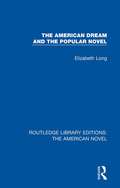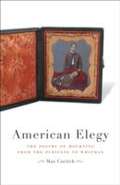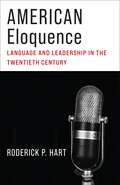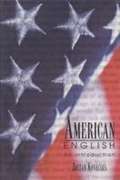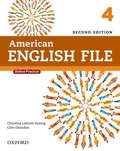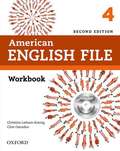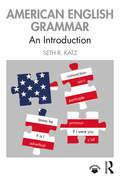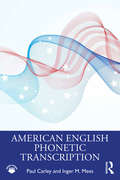- Table View
- List View
American Bloomsbury
by Susan CheeverEven the most devoted readers of nineteenth-century American literature often assume that the men and women behind the masterpieces were as dull and staid as the era's static daguerreotypes. Susan Cheever's latest work, however, brings new life to the well-known literary personages who produced such cherished works as The Scarlet Letter, Moby-Dick, Walden, and Little Women. Rendering in full color the tumultuous, often scandalous lives of these volatile and vulnerable geniuses, Cheever's dynamic narrative reminds us that, while these literary heroes now seem secure of their spots in the canon, they were once considered avant-garde, bohemian types, at odds with the establishment. These remarkable men and women were so improbably concentrated in placid Concord, Massachusetts, that Henry James referred to the town as the "biggest little place in America." Among the host of luminaries who floated in and out of Concord's "American Bloomsbury" as satellites of the venerable intellect and prodigious fortune of Ralph Waldo Emerson were Henry David Thoreau -- perpetual second to his mentor in both love and career; Louisa May Alcott -- dreamy girl and ambitious spinster; Nathaniel Hawthorne -- dilettante and cad; and Margaret Fuller -- glamorous editor and foreign correspondent. Perhaps inevitably, given the smallness of the place and the idiosyncrasies of its residents, the members of the prestigious circle became both intellectually and romantically entangled: Thoreau serenaded an infatuated Louisa on his flute. Vying with Hawthorne for Fuller's attention, Emerson wrote the fiery feminist love letters while she resided (yards away from his wife) in his guest room. Herman Melville was, according to some, ultimately driven mad by his consuming and unrequited affection for Hawthorne. Far from typically Victorian, this group of intellectuals, like their British Bloomsbury counterparts to whom the title refers, not only questioned established literary forms, but also resisted old moral and social strictures. Thoreau, of course, famously retreated to a plot of land on Walden Pond to escape capitalism, pick berries, and ponder nature. More shocking was the group's ambivalence toward the institution of marriage. Inclined to bend the rules of its bonds, many of its members spent time at the notorious commune, Brook Farm, and because liberal theories could not entirely guarantee against jealousy, the tension of real or imagined infidelities was always near the surface. Susan Cheever reacquaints us with the sexy, subversive side of Concord's nineteenth-century intellectuals, restoring in three dimensions the literary personalities whose work is at the heart of our national history and cultural identity.
American Borders: Inclusion and Exclusion in US Culture (American Literature Readings in the 21st Century)
by Paula Barba Guerrero Mónica Fernández JiménezAmerican Borders: Inclusion and Exclusion in US Culture provides an overview of American culture produced in a range of contexts, from the founding of the nation to the age of globalization and neoliberalism, in order to understand the diverse literary landscapes of the United States from a twenty-first century perspective. The authors confront American exceptionalism, discourses on freedom and democracy, and US foundational narratives by reassessing the literary canon and exploring ethnic literature, culture, and film with a focus on identity and exclusion. Their contributions envision different manifestations of conviviality and estrangement and deconstruct neoliberal slogans, analyzing hospitable inclusion in relation to national history and ideologies. By looking at representations of foreignness and conditional belonging in literature and film from different ethnic traditions, the volume fleshes out a new border dialectic that conveys the heterogeneity of American boundaries beyond the opposition inside/outside.
An American Cakewalk: Ten Syncopators of the Modern World
by Zeese PapanikolasThe profound economic and social changes in the post-Civil War United States created new challenges to a nation founded on Enlightenment and transcendental values, religious certainties, and rural traditions. Newly-freed African Americans, emboldened women, intellectuals and artists,and a polyglot tide of immigrants found themselves in a restless new world of railroads, factories, and skyscrapers where old assumptions were being challengedand new values had yet to be created. InAn American Cakewalk: Ten Syncopators of the Modern World, Zeese Papanikolas tells the lively and entertaining story of a diverse group of figures in the arts and sciences who inhabited this new America. Just as ragtime composers subverted musical expectations by combining European march timing with African syncopations, so this book's protagonists--who range from Emily Dickinson toThorstein Veblen and from Henry and William James to Charles Mingus--interrogated the modern American world through their own "syncopations" of cultural givens. The old antebellum slave dance, the cakewalk, with its parody of the manners and pretensions of the white folks in the Big House, provides a template of how the tricksters, shamans, poets, philosophers, ragtime pianists, and jazz musicians who inhabit this book used the arts of parody, satire, and disguise to subvert American cultural norms and to create new works of astonishing beauty and intellectual vigor.
American Cinematographers in the Great War, 1914–1918
by James W. Castellan Ron van Dopperen Copper C. GrahamA history of American cameramen covering the news of World War I, from the dangerous front line and the risk of execution to red tape and censorship.At the start of hostilities in World War I, when the United States was still neutral, American newsreel companies and newspapers sent a new kind of journalist, the film correspondent, to Europe to record the Great War. These pioneering cameramen, accustomed to carrying the Kodaks and Graflexes of still photography, had to lug cumbersome equipment into the trenches. Facing dangerous conditions on the front, they also risked summary execution as supposed spies while navigating military red tape, censorship, and the business interests of the film and newspaper companies they represented. Based on extensive research in European and American archives, American Cinematographers in the Great War, 1914–1918 follows the adventures of these cameramen as they managed to document and film the atrocities around them in spite of enormous difficulties.“The first book to explore the work and working conditions of American cinematographers active on the different fronts of the First World War. It is a pioneering study which has already attracted a good deal of attention in the academic and archive world.” —Historical Journal of Film, Radio and Television
American Classicist: The Life and Loves of Edith Hamilton
by Victoria HousemanA biography of the remarkable woman whose bestselling Mythology has introduced millions of readers to the classical worldEdith Hamilton (1867–1963) didn’t publish her first book until she was sixty-two. But over the next three decades, this former headmistress would become the twentieth century’s most famous interpreter of the classical world. Today, Hamilton’s Mythology (1942) remains the standard version of ancient tales and sells tens of thousands of copies a year. During the Cold War, her influence even extended to politics, as she argued that postwar America could learn from the fate of Athens after its victory in the Persian Wars. In American Classicist, Victoria Houseman tells the fascinating life story of a remarkable classicist whose ideas were shaped by—and aspired to shape—her times.Hamilton studied Latin and Greek from an early age, earned a BA and MA at Bryn Mawr College, and ran a girls’ prep school for twenty-six years. After retiring, she turned to writing and began a relationship with the pianist and stockbroker Doris Fielding Reid. The two women were partners for more than forty years and entertained journalists, diplomats, and politicians in their Washington, D.C., house. Hamilton traveled extensively around the world, formed friendships with Gertrude Stein and Ezra Pound, and was made an honorary citizen of Athens. While Hamilton believed that the ancient Greeks represented the peak of world civilization, Houseman shows that this suffragist, pacifist, and anti-imperialist was far from an apologist for Western triumphalism.An absorbing narrative of an eventful life, American Classicist reveals how Hamilton’s Greek and Roman worlds held up a mirror to midcentury America even as she strived to convey a timeless beauty that continues to enthrall readers.
The American Classics: A Personal Essay
by Denis DonoghueHow is a classic book to be defined? How much time must elapse before a work may be judged a "classic"? And among all the works of American literature, which deserve the designation? In this provocative new book Denis Donoghue essays to answer these questions. He presents his own short list of "relative" classics--works whose appeal may not be universal but which nonetheless have occupied an important place in our culture for more than a century. These books have survived the abuses of time--neglect, contempt, indifference, willful readings, excesses of praise, and hyperbole. Donoghue bestows the term classic on just five American works: Melville's Moby-Dick, Hawthorne's The Scarlet Letter, Thoreau's Walden,Whitman's Leaves of Grass, and Twain's Adventures of Huckleberry Finn. Examining each in a separate chapter, he discusses how the writings have been received and interpreted, and he offers his own contemporary readings, suggesting, for example, that in the post-9/11 era,Moby-Dickmay be rewardingly read as a revenge tragedy. Donoghue extends an irresistible invitation to open the pages of these American classics again, demonstrating with wit and acuity how very much they have to say to us now.
The American Climate Emergency Narrative: Origins, Developments and Imaginary Futures (New Comparisons in World Literature)
by Johan HöglundThe American Climate Emergency Narrative reveals reveals how much of what has been called "climate fiction" casts ecological breakdown as an emergency for American capitalist modernity rather than for the planet. The book traces the origins of this narrative back to the arrival of settler capitalism in America, when the understanding of the planet and its people as extractable resources was established. Since then, this narrative has elided the violent history of the climate crisis while at the same time leveraging the military as a bulwark against the crises capitalism has caused, the people it has uprooted, even the ailing planet itself. This is an open access book.
American Comics, Literary Theory, and Religion
by A. David LewisUnlocking a new and overdue model for reading comic books, this unique volume explores religious interpretations of popular comic book superheroes such as the Green Lantern and the Hulk. This superhero subgenre offers a hermeneutic for those interested in integrating mutiplicity into religious practices and considerations of the afterlife.
American Communication Research: The Remembered History (Routledge Communication Series)
by Ellen Wartella Everette E. DennisThis book captures the essence of a never-to-be-repeated glimpse at the history of media research. It offers a unique examination of the origins, meaning, and impact of media and communication research in America, with links to European antecedents. Based on a high-level seminar series at Columbia University's Freedom Forum Media Studies Center, the book features work by leading scholars, researchers, and media executives. Participants in the series have called the program "heroic and unprecedented." The book encompasses essays, commentaries, and reports by such leading figures as William McGuire, Elihu Katz, and Leo Bogart, plus posthumous reports by Wilbur Schramm, Malcolm Beville, and Hilde Himmelweit. It also contains original insights on the collaboration of Frank Stanton, Paul Lazarfeld, and Robert K. Merton.
American Contact: Objects of Intercultural Encounters and the Boundaries of Book History (Material Texts)
by Rhae Lynn Barnes and Glenda GoodmanHow studying material texts can help us better understand the diversity of the Americas, past and presentA Hawai’ian quilt stitched with anti-imperial messages; a Jesuit report that captures the last words of a Wendat leader; an invitation to a ball, repurposed by enslaved people in colonial Antigua; a book of poetry printed in a Peruvian penitentiary. Countless material texts—legible artifacts—resulted from the diverse intercultural encounters that characterize the history of the Americas.American Contact explores the dynamics of intercultural encounters through the medium of material texts. The forty-eight short chapters present biographies about objects that range in size from four miles long to seven by ten centimeters; date from millennia in the past to the 2000s; and originate from South America, North America, the Caribbean, and other parts of the Atlantic and Pacific worlds. Each essay demonstrates how particular ways of reading can render the complex meanings of the objects legible—or explains why and how the meanings remain illegible.In its diversity and breadth, this volume shows how the field of book history can be more inclusive and expansive. Taken together, the essays shed new light on the material practices of communicating power and resistance, subjection and survivance, in contact zones of America.Contributors: Carlos Aguirre, Ahmed Idrissi Alami, Chadwick Allen, Rhae Lynn Barnes, Molly H. Bassett, Brian Bockelman, George Aaron Broadwell, Rachel Linnea Brown, Nancy Caronia, Raúl Coronado, Marlena Petra Cravens, Agnieszka Czeblakow, Lori Boornazian Diel, Elizabeth A. Dolan, Alejandra Dubcovsky, Cecily Duffie, Devin Fitzgerald, Glenda Goodman, Rachel B. Gross, David D. Hall, Sonia Hazard, Rachel B. Herrmann, Alex Hidalgo, Abimbola Cole Kai-Lewis, Alexandra Kaloyanides, Rachael Scarborough King, Danielle Knox, Bishop Lawton, Jessica C. Linker, Don James McLaughlin, John Henry Merritt, Gabriell Montgomery, Emily L. Moore, Isadora Moura Mota, Barbara E. Mundy, Santiago Muñoz Arbeláez, Marissa Nicosia, Diane Oliva, Megan E. O’Neil, Sergio Ospina Romero, John H. Pollack, Shari Rabin, Daniel Radus, Nathan Rees, Anne Ricculli, Maria Ryan, Maria Carolina Sintura, Cristina Soriano, Chelsea Stieber, Amy Kuʻuleialoha Stillman, Chris Suh, Mathew R. Swiatlowski, Marie Balsley Taylor, Martin A. Tsang, Germaine Warkentin, Adrian Chastain Weimer, Bethany Wiggin, Xine Yao, Corinna Zeltsman.
American Crime Fiction: A Cultural History of Nobrow Literature as Art
by Peter SwirskiPeter Swirski looks at American crime fiction as an artform that expresses and reflects the social and aesthetic values of its authors and readers. As such he documents the manifold ways in which such authorship and readership are a matter of informed literary choice and not of cultural brainwashing or declining literary standards. Asking, in effect, a series of questions about the nature of genre fiction as art, successive chapters look at American crime writers whose careers throw light on the hazards and rewards of nobrow traffic between popular forms and highbrow aesthetics: Dashiell Hammett, John Grisham, William Faulkner, Ernest Hemingway, Raymond Chandler, Ed McBain, Nelson DeMille, and F. Scott Fitzgerald.
American Deadline: Reporting from Four News-Starved Towns in the Trump Era (Columbia Journalism Review Books)
by Greg Glassner Charles Richardson Sandra Sanchez Jason TogyerThe dramatic events of 2020—the presidential election, the COVID-19 pandemic, protests for racial justice—affected every corner of American life. What did these events mean for the residents of small towns and cities that are often overlooked by national newspapers? How do local stories change when they are told by journalists with roots in these communities? And what is lost as this kind of coverage disappears?American Deadline brings together dispatches from four longtime local journalists in different parts of the United States that tell the story of 2020 anew. It shares reporting from Bowling Green, Virginia; Macon, Georgia; McKeesport, Pennsylvania; and McAllen, Texas—two towns that lost their local newspapers and two where they are barely hanging on. The authors consider what makes each town distinctive and how these local perspectives tell a part of a broader American story. This book reports on how residents of these towns grapple with and talk about issues relating to race, schooling, health, immigration, deindustrialization, as well as local and national politics amid a changing and increasingly precarious information ecosystem. A distinct and intimate look at a calamitous year, American Deadline is an important book for all readers interested in the possibilities and future of local journalism.
American Dragons: Twenty-Five Asian American Voices
by Laurence YepA collection of writings by 25 Asian-Americans.
American Drama of the Twentieth Century (Longman Literature In English Series)
by Gerald M. BerkowitzIn this book Professor Berkowitz studies the diversity of American drama from the stylistic, experimental plays of O'Neill, through verse, tragedy and community theatre, to the theatre of the 1990s. The discussions range through dramatists, plays, genres and themes, with full supporting appendix material. It also examines major dramatists such as Eugene O'Neill, Arthur Miller, Sam Shephard, Tennessee Williams and August Wilson and covers not only the Broadway scene but also off Broadway movements and fringe theatres and such subjects as women's and African-American drama.
American Dream (SparkNotes Literature Guide Series)
by SparkNotesAmerican Dream (SparkNotes Literature Guide) by Edward Albee Making the reading experience fun! Created by Harvard students for students everywhere, SparkNotes is a new breed of study guide: smarter, better, faster.Geared to what today's students need to know, SparkNotes provides:*chapter-by-chapter analysis *explanations of key themes, motifs, and symbols *a review quiz and essay topics Lively and accessible, these guides are perfect for late-night studying and writing papers.
American Dream, American Nightmare: Fiction since 1960
by Kathryn HumeIn this celebration of contemporary American fiction, Kathryn Hume explores how estrangement from America has shaped the fiction of a literary generation, which she calls the Generation of the Lost Dream. In breaking down the divisions among standard categories of race, religion, ethnicity, and gender, Hume identifies shared core concerns, values, and techniques among seemingly disparate and unconnected writers including T. Coraghessan Boyle, Ralph Ellison, Russell Banks, Gloria Naylor, Tim O'Brien, Maxine Hong Kingston, Walker Percy, N. Scott Momaday, John Updike, Toni Morrison, William Kennedy, Julia Alvarez, Thomas Pynchon, Leslie Marmon Silko, and Don DeLillo. Hume explores fictional treatments of the slippage in the immigrant experience between America's promise and its reality. She exposes the political link between contemporary stories of lost innocence and liberalism's inadequacies. She also invites us to look at the literary challenge to scientific materialism in various searches for a spiritual dimension in life. The expansive future promised by the American Dream has been replaced, Hume finds, by a sense of tarnished morality and a melancholy loss of faith in America's exceptionalism. American Dream, American Nightmare examines the differing critiques of America embedded in nearly a hundred novels and points to the source for recovery that appeals to many of the authors.
The American Dream and the Popular Novel (Routledge Library Editions: The American Novel #8)
by Elizabeth LongThis title, originally published in 1985, examines conceptions of success and the good life expressed in bestselling novels – ranging from historical sagas and spy thrillers to more serious works by Updike, Bellows, Steinbeck and Mailer – published from 1945 to 1975. Using these popular books as cultural evidence, Elizabeth Long argues that the meaning of the American dream has changed dramatically, but in a more complex fashion than has been recognised by that country’s most prominent social critics. Her study presents a challenge to prevailing social-scientific views of contemporary American culture, and represents, both in theory and method, an important contribution to the study of culture and social criticism.
American Elegy: The Poetry of Mourning from the Puritans to Whitman
by Max CavitchPracticed and read form of verse in America, "elegies are poems about being left behind," writes Max Cavitch. American Elegy is the history of a diverse people's poetic experience of mourning and of mortality's profound challenge to creative living.
American Eloquence: Language and Leadership in the Twentieth Century
by Roderick P. HartWhat makes political speech powerful? How does eloquent rhetoric transcend ordinary language? Which stylistic choices allow effective orators to stir emotions and spur action? And in the age of Donald Trump, does political eloquence still matter?This book examines a wide swath of political discourse to shed new light on the meaning and significance of eloquence. Roderick P. Hart, a leading scholar of political communication, develops new ways of measuring persuasiveness and rhetorical power through the use of computer-based methods. He examines one hundred of the most important speeches of the twentieth century, given by presidents and politicians as well as leaders, activists, and cultural figures including Martin Luther King Jr., Lou Gehrig, Mario Savio, Carrie Chapman Catt, and Stokely Carmichael.Deploying the tools of the digital humanities as well as critical rhetorical analysis, Hart considers what distinguishes the linguistic properties of iconic oratory from those of more mundane texts. He argues that eloquence represents the confluence of cultural resonance, personal investment, and poetic imagination, providing empirical metrics for assessing each of these qualities. A quantitative and qualitative exploration of American political speech, this interdisciplinary book offers a powerful argument for why eloquence is essential for a functioning democracy.
American English: An Introduction
by Zoltán Kövecses<P> This book is a cultural-historical (rather than purely linguistic) introduction to American English. The first part consists of a general account of variation in American English. It offers concise but comprehensive coverage of such topics as the history of American English; regional, social and ethnic variation; variation in style (including slang); and British and American differences. <P>The second part of the book puts forward an account of how American English has developed into a dominant variety of the English language. It focuses on the ways in which intellectual traditions such as puritanism and republicanism, in shaping the American world view, have also contributed to the distinctiveness of American English.
American English: Dialects and Variation (Language in Society #45)
by Walt Wolfram Natalie SchillingThe new edition of this classic text chronicles recent breakthrough developments in the field of American English, covering regional, ethnic, and gender-based differences. Now accompanied by a companion website with an extensive array of sound files, video clips, and other online materials to enhance and illustrate discussions in the text Features brand new chapters that cover the very latest topics, such as Levels of Dialect, Regional Varieties of English, Gender and Language Variation, The Application of Dialect Study, and Dialect Awareness: Extending Application, as well as new exercises with online answers Updated to contain dialect samples from a wider array of US regions Written for students taking courses in dialect studies, variationist sociolinguistics, and linguistic anthropology, and requires no pre-knowledge of linguistics Includes a glossary and extensive appendix of the pronunciation, grammatical, and lexical features of American English dialects
American English File With Online Practice: Level 4
by Christina Latham-Koenig Clive Oxenden Paul SeligsonFour-skills American English course with a communicative methodology, engaging texts, and a strong pronunciation syllabus - designed to get students speaking. With texts and topics that make learners want to speak, American English File is the course that gets students talking. It gives you full skills coverage with a clear focus on pronunciation, plus wide-ranging support and resources too. Resources include Test Generator CD-ROMs, DVDs, Multi-ROMs, and websites. The highly popular teacher's site has extra lesson ideas and resources for you to download.
American English File Workbook
by Christina Latham-Koenig Clive Oxenden Jane HudsonFour-skills American English course with a communicative methodology, engaging texts, and a strong pronunciation syllabus - designed to get students speaking. With texts and topics that make learners want to speak, American English File is the course that gets students talking. It gives you full skills coverage with a clear focus on pronunciation, plus wide-ranging support and resources too.
American English Grammar: An Introduction
by Seth R. KatzAmerican English Grammar introduces students to American English in detail, from parts of speech, phrases, and clauses to punctuation and explaining (and debunking) numerous "rules of correctness," integrating its discussion of Standard American grammar with thorough coverage of the past sixty years’ worth of work on African American English and other ethnic and regional non-Standard varieties. The book’s examples and exercises include 500 real-world sentences and longer texts, drawn from newspapers, film, song lyrics, and online media as well as from Mark Twain, Stephen King, academic texts, translations of the Bible, poetry, drama, children’s literature, and transcribed conversation and TV and radio shows. Based on twenty years of classroom testing and revision, American English Grammar will serve as a classroom text or reference that teaches students how to think and talk not only about the mechanics of sentences but also about the deep and detailed soul and nuance of the most widely used language in human history.
American English Phonetic Transcription
by Paul Carley Inger M. MeesAmerican English Phonetic Transcription provides an accessible introduction to phonemic, phonetic, and intonational transcription with a focus on American English. Featuring exercises, revision tasks, and recordings to help students gain hands-on practice, the book takes a learning-by-doing approach and ensures students gain practice using each new symbol or concept introduced before moving on to the next. Consisting of three parts, the book covers: transcribing individual words, including consonants, vowels, primary stress, secondary stress, syllabic consonants, and inflections; transcribing phrases and sentences, including weak forms, elision, and assimilation; transcribing intonation, including the structure of English intonation and recognizing pitch patterns. Ideally suited as a standalone workbook or for use alongside British English Phonetic Transcription, American English Phonetic Transcription is key reading for undergraduate students of linguistics as well as anyone teaching or learning English as a foreign language.
